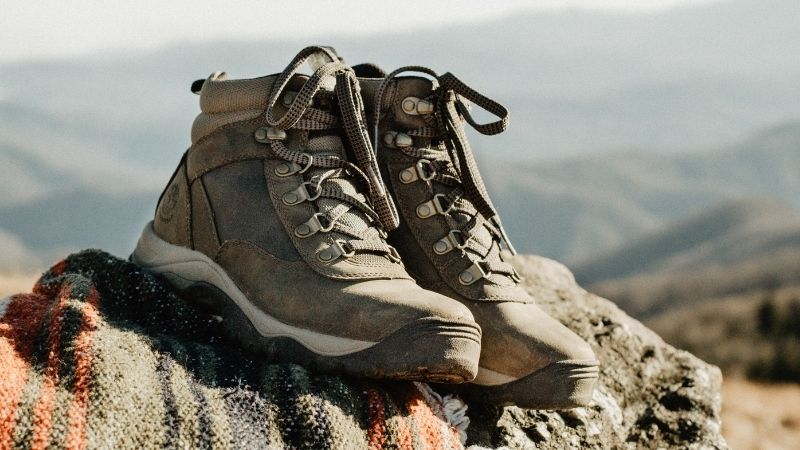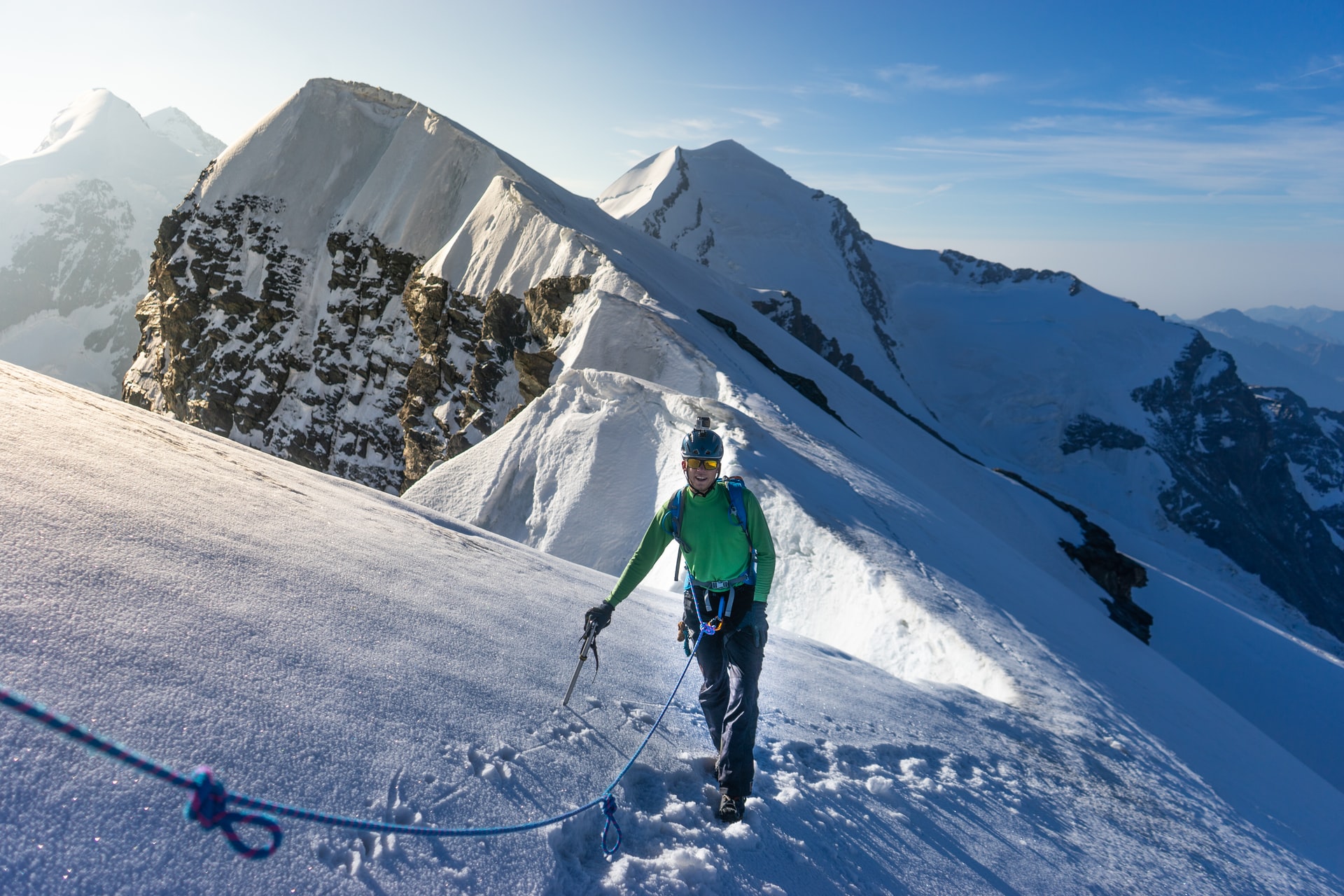
Top 9 Mountaineering Boots In 2024

“Scarpa” is Italian for footwear excellence. The Phantom Tech excels in every category. They’re warm and about as waterproof as it gets. They incorporate a zippered gaiter over the laces which locks in heat and keeps out moisture, a big plus for long distance missions. At 875 g, they’re a winner in terms of weight, too. This makes them a wildly popular boot.
As far as technical performance is concerned, the Phantom Tech are very stiff boots, a plus for snow and mixed ascents. They also feature heel and toe welts, making them compatible with automatic and semi-automatic crampons. The only real setback here is the cost.
Before you can follow the urge to go stomping up into the alpine, you need to think about your feet. Snowy or dry, big mountains are tough on your shoes.
In most cases, your standard hiking boots won’t handle the wear and tear of extended use on rocks, snow, and ice. To me, that makes mountaineering boots one of the most crucial pieces of gear in your rack.
So what boots should you choose when preparing for a big trip in the mountains? In this guide, I’ll give you the ins and outs of what to look for, along with the top ten mountaineering boots on the market in 2023. Let’s get into it!
My Review Process
Over the last two-ish decades, I’ve had my fair share of escapades in the mountains. Between climbing and skiing the Wasatch of Utah to tromping through the glaciated volcanoes of the Cascades, I’ve seen a lot. I know what it takes to complete an ascent, and how to prepare for big adventures.
With that in mind, I set my feelers out to see what’s new in mountaineering boot design and technology. After thoroughly researching everything available on the market, I weighed pros and cons to find the best boots in each category. Here are the results.
Best Overall Mountaineering Boots
“Scarpa” is Italian for footwear excellence. The Phantom Tech excels in every category. They’re warm and about as waterproof as it gets. They incorporate a zippered gaiter over the laces which locks in heat and keeps out moisture, a big plus for long distance missions. At 875 g, they’re a winner in terms of weight, too. This makes them a wildly popular boot.
As far as technical performance is concerned, the Phantom Tech are very stiff boots, a plus for snow and mixed ascents. They also feature heel and toe welts, making them compatible with automatic and semi-automatic crampons. The only real setback here is the cost.
Best Value Mountaineering Boots
If you’re just getting into mountaineering and want a lot of value for your dollar, go La Sportiva. Tower Extreme performs well on rocky and mixed conditions. It’s a good entry point for new mountaineers looking to push into harsh, steep terrain and conditions.
They’re warm, light, and feature toe and heel welts for crampon compatibility. For all your basic objectives, this boot will more than get the job done.
However, the Trango Tower Extreme isn’t what you should pick for multi-day ascents. The synthetic material reduces durability and lack of a gaiter will limit how long you can be out in them.
Best Mountaineering Boots for Men
A runner-up for best all-around boot, the Arc’teryx Acrux AR is sleek and functional. It features a full gaiter, like the Phantom, as well as a removable lining. This earns it some extra points for climbing in cold weather conditions. They’re incredibly waterproof, which is a must if you’re on snow or ice for a long time. This is a popular boot among fans of mixed ascents.
There are two drawbacks to this boot. Despite being compatible with automatic crampons, the Acrux AR is a little too flexible for really strong climbing performance. In addition, the cost can be prohibitive for many new mountaineers. Given all the positive features, these are minor issues.
Best Mountaineering Boots for Women
For womens’ mountaineering boots, the Mammut Kento High GTX is a clear winner. It’s comfortable, lightweight, and built with a Gore-tex membrane for waterproofing. Vibram soles perform well on rock and dirt, and the heel welt allows for semi-automatic crampon use. It’s a good all-rounder that won’t break the bank.
The downsides are the lack of technical features. The Kento High GTX won’t work with automatic crampons, and it lacks a gaiter. This makes it less of a good choice for ice climbs and winter ascents. But if you’re looking for a strong three-season boot, the Kento High GTX can handle just about anything.
Best Durable Mountaineering Boots
Perfectly balancing lightweight construction with superior durability, the Asolo Alta Via is a rock solid durable boot. They’re designed with high rubber rands that withstand abrasion and crampon spikes. The soles are stiff enough to perform well on rock and mixed conditions, without slowing you down on the approach. Best of all, they’ll last you a while.
On the flipside, they’re not especially warm. This can be counteracted by spending a little more on socks, but it’s something to take into account if you live in the Rockies or have dreams of climbing in Alaska or the Himalayas.
Best Comfortable Mountaineering Boots
The Asolo Freney Mid GV mountaineering boots are as suited to hiking as they are to technical ascents on rock and snow. The soles aren’t too stiff to hike on dirt, which will help on high mileage days. The fit and ankle support are both great. Overall, they get the gold for Most Comfortable Boots. They’re also made with Gore-tex for waterproofing.
However, hiking comfort comes at the cost of some features. The Freney Mid GV features only a heel welt, meaning you’ll have to use semi-automatic crampons. These aren’t the boots you’ll want to take for technical ice and mixed climbing.
Best 3-season Mountaineering Boots
The Scarpa Ribelle Tech HD was made to defy classification. It’s a hybrid between a heavy duty trail runner and a technical mountaineering boot. This mountaineering boot is ultralight, with a built-in gaiter and lace covering for extra waterproofing. That’s a must if you’re doing long days on melty snow. For snow, rock, and trail performance, this boot is king.
The downside is that it’s a mountaineering boot specialized for one job. It won’t perform quite as well on ice, and probably isn’t sufficient for winter ascents. You can’t always win them all.
Best Summer Mountaineering Boots
You don’t need to break the bank on a pair of mountaineering boots if you’re only getting out during the warm months. You need durability and good scrambling performance, but insulation and full automatic crampon support aren’t required. If you can also get lightweight, that’s a bonus.
Enter the Scarpa Zodiac. It performs like a heavy duty approach shoe, with a leather upper for superior durability. In addition, the heel welt provides semi-automatic crampon compatibility for snow ascents. It’s also the lightest boot on this list.
However, it’s a little stiff for long trail hikes. Adding an insole might be smart if you’ve got lots of mileage to cover.
Best Ice Climbing Mountaineering Boots
When you’re on vertical ice, you’re counting on balancing your whole weight over the points of your crampons. You need a super supportive boot with toe and heel welts. And in case you accidentally kick yourself, durable leather is the preferred material. The La Sportiva Nepal Cube fits this description perfectly. They also resist water and trap heat well, which is a must for long ice climbs.
But there is one drawback here, namely weight. The Nepal Cube is one of the heaviest pairs of mountaineering boots on the market. But if ice performance is a must, it’s hard to avoid adding some extra weight.
Tips For Picking The Right Mountaineering Boots
Let’s flesh out some of the criteria we look at when grading a pair of mountaineering boots. Not every boot does every job, and different routes require different boots. In general, mountaineering boots are divided into 3-season, 4-season, and high elevation boots.
3-season Boots
3-season mountaineering boots are designed to tackle a mix of dirt, rock, and snow. You may get into some steep snow and ice climbing with them, but for the most part you won’t be using them with crampons. 3-season boots typically have “softer” soles and designs emphasize breathability, durability, and lightweight construction.
4-season Boots
4-season boots need to be able to handle extreme cold for extended periods, so they crank warmth and waterproofing to 11. They’re also designed with ice climbing in mind, so most boots have both toe and heel welts for automatic crampons. These are extra stiff boots for kicking steps in snow and ice, so they won’t be the most comfortable boots for summertime hiking.
High Elevation Boots
When we say “high elevation,” we mean really high elevation - think Aconcagua or Mount Everest.
These are 4-season boots on steroids. High elevation boots feature extra high gaiters for warmth, thick and durable waterproofing, and removable liners. They don’t flex at all since you’ll never be hiking on dirt with them.
What Makes A Good Mountaineering Boot?
Mountaineering boots have just as many features as any other piece of gear. So how do these features translate to how the boots are made? Things to note are the:
Outer Materials
The main two options here are leather or synthetic. Synthetic materials save weight but aren’t as durable as leather. They’re more common on 3-season boots. 4-season boots often integrate a leather shank with a synthetic gaiter for more waterproofing and warmth.
Weight
Obviously we’re always trying to carry less. But a little heft can help you kick into ice, or kick steps in snow. Sometimes weight is just how you pay the piper for warmth and durability.
Insulation
Insulation adds weight, plain and simple. Summer boots will use lighter, thinner membranes to keep your feet cool. Winter boots often use removable liners, like ski boots, to maximize warmth.
Lacing Systems
Your laces allow you to tailor the fit of your boots. And you definitely don’t want them coming loose during a sketchy downclimb. If reviews cite a clunky lacing system, that’s a red flag. Some boots integrate Boa laces, which are simple to tighten, but don’t let you tweak the fit as much as traditional laces.
Crampon Compatibility
The way your crampons integrate with your boots is crucial. The best models use toe and heel welts (little plastic lips similar to those on ski boots) to clip on automatic crampons.
If you don’t plan on using crampons as much, having just heel welts is sufficient for semi-automatic crampons. Having welts is generally better than not, if you can afford it.
What Do Mountaineering Boots Cost?
For something you can count on, you should expect to pay at least $300 for a 3-season boot. Some may shy away from this figure, but if you find yourself in the alpine in adverse conditions, you’ll be glad to have something that can handle it.
4-season boots usually range from $400-800. High elevation mountaineering boots can cost more than $1,000 per pair.
Summary
Our overall winner here is the Scarpa Phantom Tech. If you have the budget for it, it’s the champ for overall performance. For new mountaineers with tight budgets, the Sportiva Trango Tower Tech is the best option. For women, the Mammut Kento High GTX is a standout boot.
Common questions

*The information on this site is based on research and first-hand experience but should not be treated as medical advice. Before beginning any new activity, we recommend consulting with a physician, nutritionist or other relevant professional healthcare provider.














